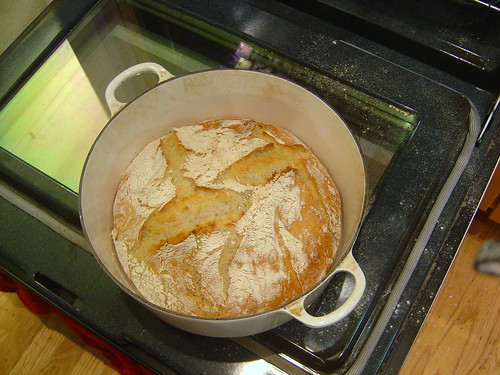
This bread is almost effortless to make because it requires no kneading. Instead, the dough is allowed to slowly rise over a long period of time. Then it is baked in a preheated covered cast-iron pot, which helps produce a crispy, bakery-style crust on the finished loaf.
Ingredients:
3 cups all-purpose flour
1/4 tsp. active dry yeast
1 3/4 tsp. salt
2 tsp. chopped fresh rosemary
2 tsp. chopped lemon zest
1 1/2 cups water (cold tap is fine)
Cornmeal as needed
Directions:
In a large bowl, combine the flour, yeast, salt, rosemary and zest. Add 1 1/2 cups water and stir until blended; the dough will be shaggy and very sticky. Cover the bowl with plastic wrap. Let the dough rest at warm room temperature (about 70°F) until the surface is dotted with bubbles, 12 to 18 hours.
Place the dough on a lightly floured work surface. Sprinkle the dough with a little flour and fold the dough over onto itself once or twice. Cover loosely with plastic wrap and let rest for 15 minutes.
Using just enough flour to keep the dough from sticking to the work surface or your fingers, gently and quickly shape the dough into a ball. Generously coat a cotton towel, preferably a flour sack towel (not terry cloth), with cornmeal (I used flour). Put the dough, seam side down, on the towel and dust with more flour or cornmeal. Cover with another cotton towel and let rise until the dough is more than double in size and does not readily spring back when poked with a finger, about 2 hours.
At least 30 minutes before the dough is ready, put a 2 3/4-quart cast-iron pot in the oven and preheat the oven to 450°F. I doubled this recipe and it fit well into my 8 quart Le Crueset.
Carefully remove the pot from the oven. Slide your hand under the towel and turn the dough over, seam side up, into the pot; it may look like a mess, but that is OK. Shake the pan once or twice if the dough is unevenly distributed; it will straighten out as it bakes. Cover with the lid and bake for 30 minutes. Uncover and continue baking until the loaf is browned, 15 to 30 minutes more.
Transfer the pot to a wire rack and let cool for 10 minutes. Using oven mitts, turn the pot on its side and gently turn the bread; it will release easily. Makes one 1 1/2-lb. loaf.
Adapted from Sullivan Street Bakery (New York City) and Mark Bittman, "The Secret of Great Bread: Let Time Do the Work," The New York Times, Nov. 8, 2006.

2 comments:
Will this work with gluten free flour, do you think? I use Tom Sawyer flour, which is a very fine baking flour.
I don't know if it will work since bread is all about gluten. Especially this method, as it takes so long because the gluten molecules are slowly lining up and organizing themsleves.
Post a Comment